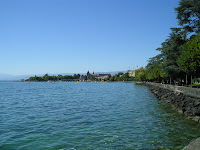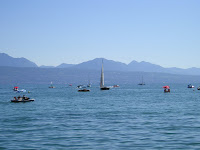Though the sun was shining and the weather ultimately turned out to be quite warm, there was a crisp bite to the air this morning that felt much more like October than August. After a beautiful summer I guess I’m not really in a position to complain if a change of seasons is indeed upon us. However, it’d be great to get another month or so of summer if possible.
Perhaps motivated by the first sign of a potential season change, I decided to head down to the lake today. It turned out that the Lausanne triathlon was being held, so there was a considerable amount of activity lakeside.
Perhaps motivated by the first sign of a potential season change, I decided to head down to the lake today. It turned out that the Lausanne triathlon was being held, so there was a considerable amount of activity lakeside.


To get a little space, I ended up walking along the lake to Pully, which is just east of Lausanne. These are some pictures that I took along the way.




It must have been in the low-80s by the time I got back to Lausanne, so it seems as though summer is still with us. That said, given the number of people out taking advantage of the beautiful day, I definitely got the impression that most may share the opinion that we’re perhaps on borrowed time before the reality of fall sets in.




























